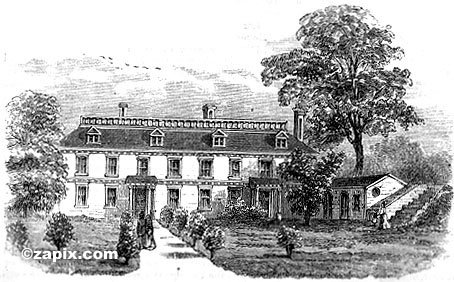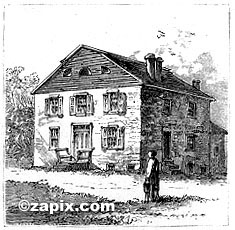|
|
The Romance of the Hudson, Part I, continued
house, and was pierced with port-holes for cannon and loop-holes for musketry, and is probably full two hundred years old. On account of its great strength and. Armament it was called Castle Philipse. There the first lord of the manor lived in rugged feudal style until the lower manor-house was built at Yonkers.
purposes by the public authorities of Yonkers. The more ancient part was built soon after the purchase of the property in 1682. There the Hon. Frederick Philipse, of a noble Bohemian family, and second lord of the manor, lived in almost princely style after the house assumed its present shape and size in 1745. Its rooms are large and wainscoted; its ceilings are high, and the whole interior shows tokens of wealth and taste. In the drawing-room, the ceiling of which is ornamented with arabesque-work, the charming Mary Philipse, daughter of Lord Frederick, was married to Captain Roger Morris, already mentioned, in January, 1758.
During the Revolution there were at different times many stirring military scenes at Dobb's Ferry and on the waters near, where the Americans had a block-house and two redoubts. A portion of one of the latter may be seen in excellent preservation on the beautiful grounds of Mrs. G. W. Hatch, adjoining those of the present owner (Mr. Archer) of the Livingston place. A few miles above Dobbs Ferry, and just north of Irvington station, may be seen, on the low bank of the river, half concealed by the foliage, the white cottage of "Sunnyside," around which cluster pleasant memories of its late beloved owner. Some of the best of Irving's romances of the Hudson are connected with that charming home of his, such as Wolfert's Roost and the Legend of Sleepy Hollow. The cottage itself is a romance. It was originally a stone building, Irving says, with many gables, and modeled after Governor Stuyvesant's cocked hat. It was built by Wolfert Acker, a self-exiled privy councilman of Stuyvesant's court as an asylum from trouble. He was fretting his life away in the city because nobody agreed with him. He did not find rest there. His wife opposed him as much as did the citizens, and, the chronicler says, "the cock of the roost was the most hen-pecked bird in the county." purposes by the public authorities of Yonkers. The more ancient part was built soon after the purchase of the property in 1682. There the Hon. Frederick Philipse, of a noble Bohemian family, and second lord of the manor, lived in almost princely style after the house assumed its present shape and size in 1745. Its rooms are large and wainscoted; its ceilings are high, and the whole interior shows tokens of wealth and taste. In the drawing-room, the ceiling of which is ornamented with arabesque-work, the charming Mary Philipse, daughter of Lord Frederick, was married to Captain Roger Morris, already mentioned, in January, 1758. The Roost passed into the possession of Jacob Van Tassel, a valiant Dutchman and a Whig, whose long goose gun became the terror of "Cow-boys" and "Skinners" and marauding craft on the river, and secured the dwelling from violence. Alas! Jacob was made a prisoner by the British, and he and his goose gun were carried to New York. The Roost was then garrisoned by Jacob's stout wife and stouter sister and still stouter Dinah, a negro servant. One day a boatful of armed men came from a British ship to attack the "Rebel Nest," as the Roost was called. The garrison flew to arms. They seized mops, pokers, shovels, tongs, and broomsticks, and gave terrible volleys of words. There was a dreadful uproar, but in vain. The house was plundered and burned, and the invaders tried to carry off Laney Van Tassel, the beauty of the Roost. Then came the tug of war. Mother, aunt, and Dinah flew to the rescue. The struggle continued to the water's edge, when a trumpet-voice from the ship bade the men desist. So the beauty escaped "with only a rumpling of the feathers." The Roost was  The Philipse Manor-House.
|
|
|
Page 10
Books & articles appearing here are modified adaptations
from a private collection of vintage books & magazines. Reproduction of these pages is prohibited without written permission. © Laurel O'Donnell, 1996-2006.
|
||


